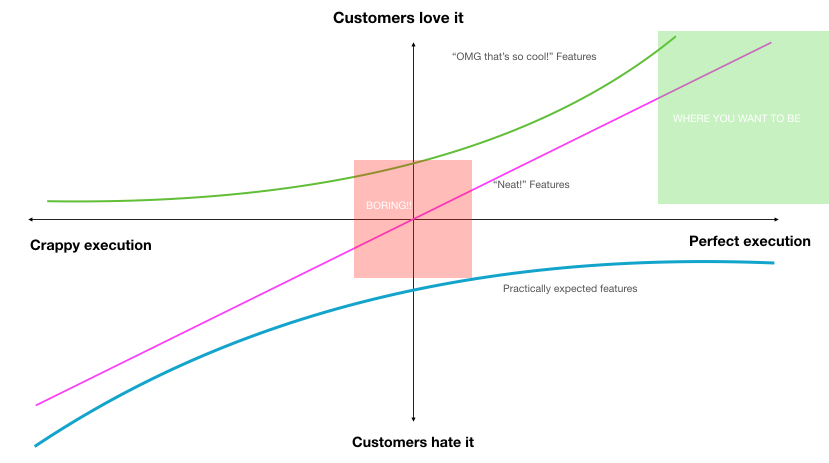The Kano Model: What it is and how to use it to smoke the competition
The Kano model is a tool that can help product managers differentiate their products from the competition and serve as a prioritization tool to determine what goes on the roadmap.
Let’s say that you’re managing an existing product in a competitive market. Your customers have a lot of choices and a lot of options when choosing a product like yours. All of the choices are pretty similar and competition is fierce.
In this scenario, it’s easy to get into the habit of churning out unordinary features.
Your competitor releases a new standard feature and now you feel like you need to as well.
So, what’s a PM to do? Well, you can either try to keep up with the joneses and release a very average product. Or you can implement the Kano model and start releasing performance and delightful features alongside your standard “must-have” features.
Kano in Practice
Let’s say that you’re the product manager of a minivan.
There are lots of options that prospective customers can choose from and your customers expect a certain bare minimum of features. Think airbags or antilock braking.
They also want to have some “nice to haves” like Bluetooth and power seats.
But what they’re really going to buy the product on and rave about to all of their friends is the delight features that are included in your product. Maybe this is a backseat temperature control system for the kiddos so they don’t bug you, or maybe it’s like an air filter that helps de-stinkify the forgotten McDonald’s fry that somehow landed up wedged between the seats. Or maybe it’s a mode for keeping your dog cool during a hot summer day while you run to pick up some dry cleaning.
These “delight” features are what you’re striving for.
The goal of the Kano model is to build the things that’ll delight your customers and avoid building features that customers don’t care about or flat out don’t like.
Kano in theory
This is the Kano model. As you can see on the x-axis, we have varying levels of execution.

Now on the very left, we have a feature that may be executed poorly, or maybe it’s just like an MVP, like version 0.1.
To the right on the x-axis, we have things that are perfectly executed.
On the Y-axis we have our customer satisfaction. So towards the top, those are the things that customers love. On the bottom are things that customers hate.
We also have these three imaginary lines that you can see. The blue line is a representation of those features that are practically expected.
The green line at the top is those really cool, delightful features that everyone loves to have.
In the middle are the neat features, things that add value, improve customer satisfaction, but aren’t quite so delightful, and are a little bit above the necessary minimum.
You and your competitors may be stuck in this boring square. It’s not a fantastic place to be.
You actually want to be in the green square. The place where customers are amazed by your product.
The Kano key - talking to your customers
Now the Kano model can seem a little bit abstract at first. There’s really no math. It’s all qualitative lines and talking to your customers.
To get started, you merely have to talk to your customers, figure out what kind of features they want, where they fit and build that stuff that’s in the upper right-hand corner.
If you’re in a competitive market, the Kano model is definitely something that you should not ignore. It can help you really stand out from your competitors, figure out which features to build and really get in touch with your customer’s wants and desires.
